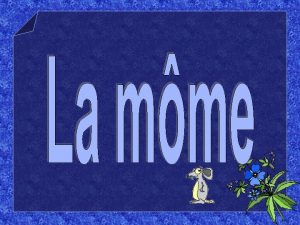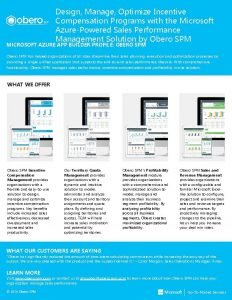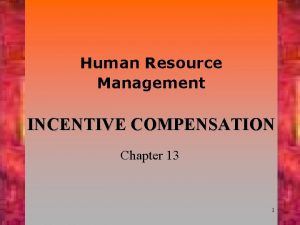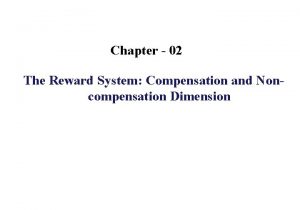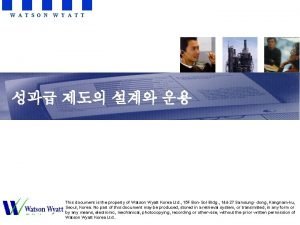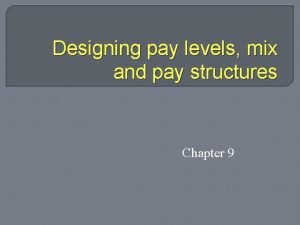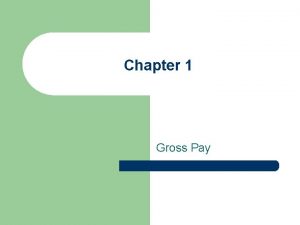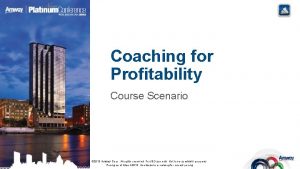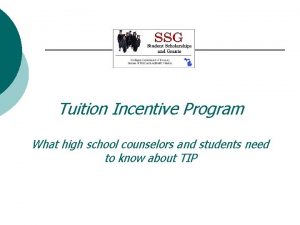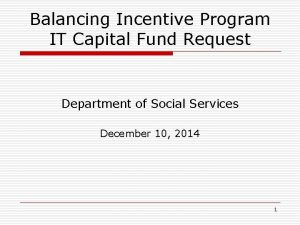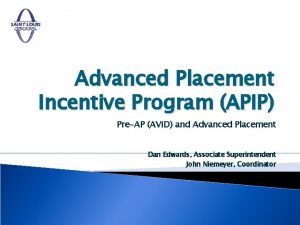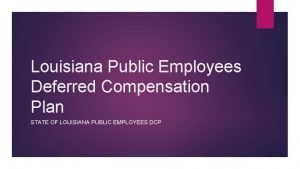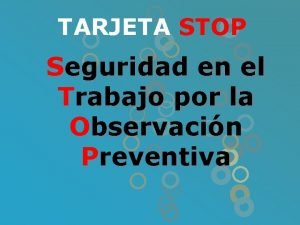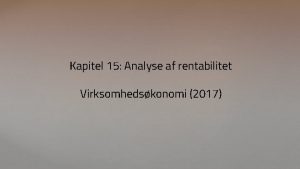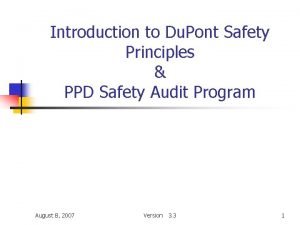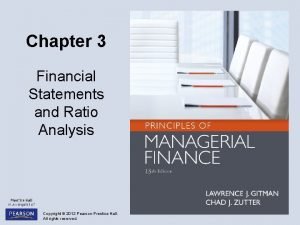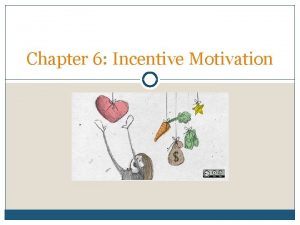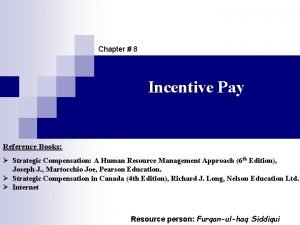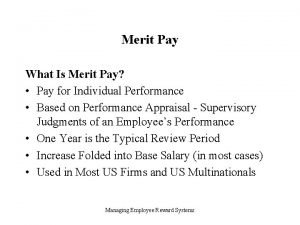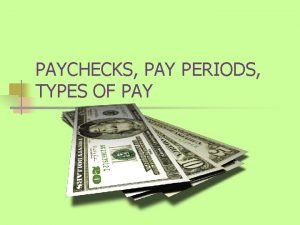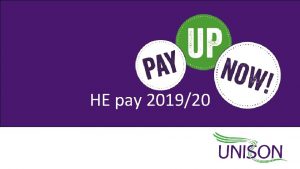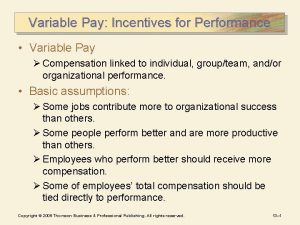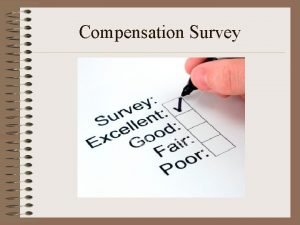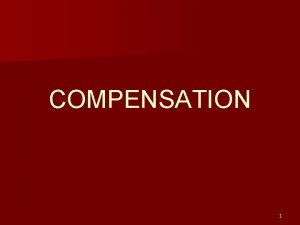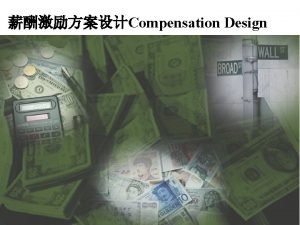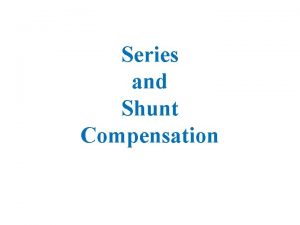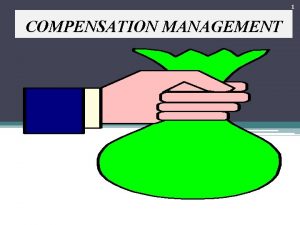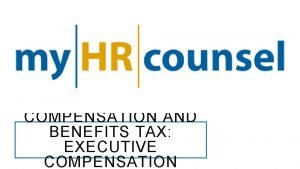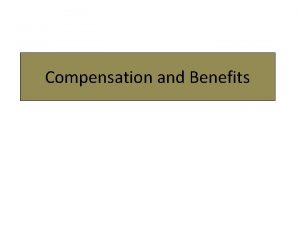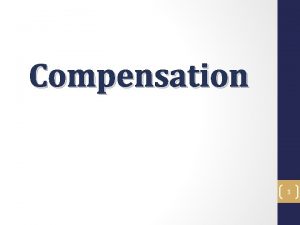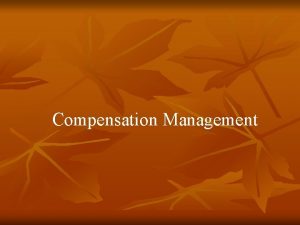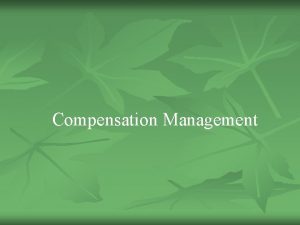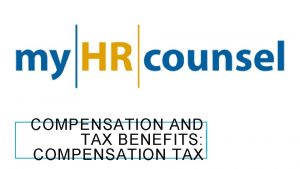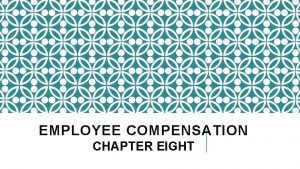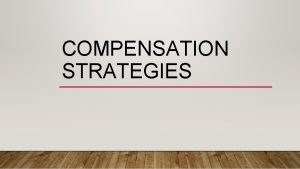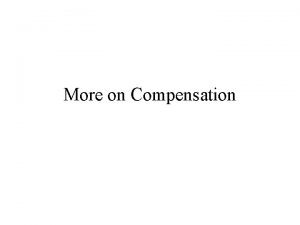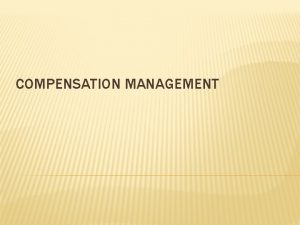Incentive Compensation p Dupont 1988 Incentive pay program
























- Slides: 24

Incentive Compensation p Dupont 1988: Incentive pay program instituted covering nearly 20, 000 employees n 6% of annual pay put at risk depending on company performance This slideshow was written by Ken Chapman, but is substantially based on concepts from Managerial Economics and Organizational Architecture by Brickley Zimmerman & Smith, Mc. Graw-Hill, 2004.

Forms of Incentive Pay p p p p p Piece rates and commissions Bonuses Prizes Salary revisions based on performance Promotions Preferred assignments Stock ownership Firings and penalties based on performance Deferred compensation (e. g. , un-invested pensions) that are lost on dismissal This slideshow was written by Ken Chapman, but is substantially based on concepts from Managerial Economics and Organizational Architecture by Brickley Zimmerman & Smith, Mc. Graw-Hill, 2004.

Is Incentive Pay Desirable? p Example: Stock as part of Compensation n n CEOs Janitors Students: Grading based on the class average p Example: Professor’s reward for research p Example: MD’s and utilization review p This slideshow was written by Ken Chapman, but is substantially based on concepts from Managerial Economics and Organizational Architecture by Brickley Zimmerman & Smith, Mc. Graw-Hill, 2004.

The Basic Incentive Problem Assume effort costless to observe p Employees want to be happy p n n p Firm’s want employees to work hard n p U = I – e 2 Reservation utility = 1000 B = $100 e What is the optimum effort? n Profit = 100 e – (1000+e 2) This slideshow was written by Ken Chapman, but is substantially based on concepts from Managerial Economics and Organizational Architecture by Brickley Zimmerman & Smith, Mc. Graw-Hill, 2004.

The Basic Incentive Problem Benefits and Costs in $ Cost of Effort = 1000+e 2 Benefit of Effort= 100 e Level of Effort This slideshow was written by Ken Chapman, but is substantially based on concepts from Managerial Economics and Organizational Architecture by Brickley Zimmerman & Smith, Mc. Graw-Hill, 2004.

The Basic Incentive Problem Benefits and Costs in $ Cost of Effort = 1000+e 2 Benefit of Effort= 100 e e*=50 Level of Effort This slideshow was written by Ken Chapman, but is substantially based on concepts from Managerial Economics and Organizational Architecture by Brickley Zimmerman & Smith, Mc. Graw-Hill, 2004.

Lessons from the example If interests are aligned, there is no problem p Incentive conflicts are no problem when they are contractible p There is a tradeoff between the benefits to the firm and the cost to employees p This slideshow was written by Ken Chapman, but is substantially based on concepts from Managerial Economics and Organizational Architecture by Brickley Zimmerman & Smith, Mc. Graw-Hill, 2004.

Incentives from Ownership Suppose effort is not observable, but that employees are paid for their output. p Maximize U = ($100 e – $1, 500)- e 2 p Limitations of this approach p n n n Wealth Constraints Risk Aversion Team Production This slideshow was written by Ken Chapman, but is substantially based on concepts from Managerial Economics and Organizational Architecture by Brickley Zimmerman & Smith, Mc. Graw-Hill, 2004.

Optimal Risk Sharing p Abby: n n p Jess: n n p Monthly income from trust fund is worth either $0 or $10, 000 with probability. 5 Expected Income =$5, 000 Same income stream, same probabilities. Probabilities are independent. Assuming the two are risk-averse, can they gain by pooling assets This slideshow was written by Ken Chapman, but is substantially based on concepts from Managerial Economics and Organizational Architecture by Brickley Zimmerman & Smith, Mc. Graw-Hill, 2004.

Optimal Risk Sharing Joint Outcome Probability Individual Payoff from splitting ($0; $0) . 25 $0 ($0; $10, 000) . 25 $5, 000 ($10, 000; $10, 000) . 25 $10, 000 Expected Income = $5, 000 This slideshow was written by Ken Chapman, but is substantially based on concepts from Managerial Economics and Organizational Architecture by Brickley Zimmerman & Smith, Mc. Graw-Hill, 2004.

Effective Incentive Contracts p Tradeoff between risk sharing and incentives n n From a risk-sharing viewpoint it is better to have fixed salaries Fixed salaries do not provide strong incentives This slideshow was written by Ken Chapman, but is substantially based on concepts from Managerial Economics and Organizational Architecture by Brickley Zimmerman & Smith, Mc. Graw-Hill, 2004.

Principal-Agent Model p Principal n n p The one writing the contract The employer Agent n n The one working on the principal’s behalf The employee This slideshow was written by Ken Chapman, but is substantially based on concepts from Managerial Economics and Organizational Architecture by Brickley Zimmerman & Smith, Mc. Graw-Hill, 2004.

Principal-Agent Example p Erica works for DNAcorp n n n Erica’s Output (Q) is determined by her effort (e) and some random events out of her control ( ). The variance of these random events is 2. Q= e + Erica’s personal costs = e 2 p Owner’s Profit = ( e + ) – W p W is the wage paid to Erica Suppose Compensation =$1000+. 2*($100 e + ) n This slideshow was written by Ken Chapman, but is substantially based on concepts from Managerial Economics and Organizational Architecture by Brickley Zimmerman & Smith, Mc. Graw-Hill, 2004.

Erica’s Effort Choice Costs in $ Costs to Erica= e 2 Compensation= 1000+20 e e*=10 Level of Effort This slideshow was written by Ken Chapman, but is substantially based on concepts from Managerial Economics and Organizational Architecture by Brickley Zimmerman & Smith, Mc. Graw-Hill, 2004.

Erica’s Effort Choice Costs in $ Costs to Erica= e 2 Compensation = 1000+30 e Compensation= 1000+20 e e*=10 e*=15 Level of Effort This slideshow was written by Ken Chapman, but is substantially based on concepts from Managerial Economics and Organizational Architecture by Brickley Zimmerman & Smith, Mc. Graw-Hill, 2004.

Factors that Favor Incentive Pay The value of the output is sensitive to employee effort p The employee is not very risk-averse p The level of risk that is beyond the employee’s control is low p The employee’s response to incentives is high p The employees output can be measured at low cost p This slideshow was written by Ken Chapman, but is substantially based on concepts from Managerial Economics and Organizational Architecture by Brickley Zimmerman & Smith, Mc. Graw-Hill, 2004.

Informativeness Principle p Include all performance indicators that provide additional information about the employee’s effort if they can be included at low cost. Greater precision in the measure reduces the cost of inefficient risk bearing. This slideshow was written by Ken Chapman, but is substantially based on concepts from Managerial Economics and Organizational Architecture by Brickley Zimmerman & Smith, Mc. Graw-Hill, 2004.

Group Incentive Pay p Advantages n n n May be easier to measure Encourages cooperation and teamwork Employees monitor each other This slideshow was written by Ken Chapman, but is substantially based on concepts from Managerial Economics and Organizational Architecture by Brickley Zimmerman & Smith, Mc. Graw-Hill, 2004.

C. E. O. Compensation Why are CEO’s paid more? p Japanese CEO’s receive less than their US counterparts. Why? p When incentive pay for CEO’s is announced, the stock price rises. Why? p This slideshow was written by Ken Chapman, but is substantially based on concepts from Managerial Economics and Organizational Architecture by Brickley Zimmerman & Smith, Mc. Graw-Hill, 2004.

Sample Problems 15 -1. Evaluate the statement: “investment banking is a demanding profession: investment banks want their employees to work as hard as possible. ” This slideshow was written by Ken Chapman, but is substantially based on concepts from Managerial Economics and Organizational Architecture by Brickley Zimmerman & Smith, Mc. Graw-Hill, 2004.

Sample Problems 15 -Discuss the tradeoffs between efficient risk-bearing and incentives in compensation packages. This slideshow was written by Ken Chapman, but is substantially based on concepts from Managerial Economics and Organizational Architecture by Brickley Zimmerman & Smith, Mc. Graw-Hill, 2004.

Sample Problems 15 -18. Consider two successful sales companies. One company pays its salespeople a high commission, whereas the other pays its salespeople a straight salary. Assume that both companies are paying their salespeople in an optimal manner. Explain potential differences in the firms that might help to explain the differences in the pay policies. This slideshow was written by Ken Chapman, but is substantially based on concepts from Managerial Economics and Organizational Architecture by Brickley Zimmerman & Smith, Mc. Graw-Hill, 2004.

Sample Problems 15 -8. Evaluate the following statement: “John is paid a straight salary with no bonus pay. Obviously, he has no incentives to do a good job. ” This slideshow was written by Ken Chapman, but is substantially based on concepts from Managerial Economics and Organizational Architecture by Brickley Zimmerman & Smith, Mc. Graw-Hill, 2004.

Sample Problems 15 -7. Some school districts have compensated teachers based on the performance of students on standardized tests. Do you think this is a good idea? Explain. This slideshow was written by Ken Chapman, but is substantially based on concepts from Managerial Economics and Organizational Architecture by Brickley Zimmerman & Smith, Mc. Graw-Hill, 2004.
 Edith giovanna gassion
Edith giovanna gassion Merit pay vs incentive pay
Merit pay vs incentive pay Designing and managing incentive compensation programs
Designing and managing incentive compensation programs Incentive compensation in hrm
Incentive compensation in hrm Compensation and non compensation dimensions
Compensation and non compensation dimensions Incentive based pay
Incentive based pay Paycheck
Paycheck Designing a pay structure
Designing a pay structure 1-3 commission worksheet answers
1-3 commission worksheet answers Amway 300pv
Amway 300pv Indian incentive program
Indian incentive program Microsoft azure channel incentive
Microsoft azure channel incentive Partner incentive program microsoft
Partner incentive program microsoft Tuition incentive program
Tuition incentive program Balancing incentive program
Balancing incentive program Advanced placement incentive program
Advanced placement incentive program Ny medicaid ehr incentive program
Ny medicaid ehr incentive program Csu doctoral incentive program
Csu doctoral incentive program Verizon volunteer incentive program
Verizon volunteer incentive program State of louisiana deferred compensation plan
State of louisiana deferred compensation plan Tarjetas stop de seguridad
Tarjetas stop de seguridad Simon dupont
Simon dupont Dupont pyramiden
Dupont pyramiden Dupont safety presentation
Dupont safety presentation Types of ratios
Types of ratios
